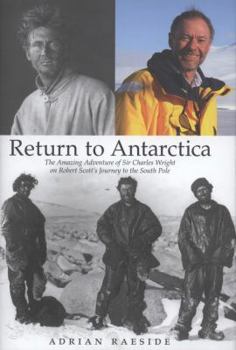Return to Antarctica: The Amazing Adventure of Sir Charles Wright on Robert Scott's Journey to the South Pole
Select Format
Select Condition 
Book Overview
By 1910, the Antarctic was the last place on earth that had never been explored, and British naval officer Robert Scott was obsessed that an Englishman - specifically himself - should conquer the pole. Despite being under-funded, under-equipped and unprepared, Scott sailed south in the antiquated whaling ship, Terra Nova, in what everyone assumed would be a cracking good adventure. The expedition was made up entirely of British adventurers, gadabouts and scientists, the exception being one Canadian, Charles Seymour (Silas) Wright. Born 1887 in Toronto, Charles Wright was studying physics in Cambridge when he heard Scott was looking for a physicist to join the expedition to the pole. By the time Wright inquired, Scott had chosen a physicist for the team but was short a glaciologist. Who else but a Canadian would know about glaciers? Wright became the expedition's glaciologist. Halfway through the rough passage to the Antarctic, Scott got word that a rival explorer, Norwegian Roald Amundsen, was also making a run for the pole and was close on their heels. What started out as a stroll to the South Pole became a race between two very determined and different men. Arriving at their base camp on Cape Evans in January 1911, Scott's team soon discovered they were unprepared for the Antarctic, while equipment failures and food shortages compounded the hardship. For the final race to the pole, Scott stripped the team down to four men, and Wright did not make the cut. Scott reached the geographic South Pole only to find that Amundsen had beaten them by days. Bitterly disappointed, Scott and his companions returned to base camp, but were caught in a fierce Antarctic blizzard that raged for days. Too weak to pull their sleds and out of food and fuel, they froze to death. Ironically, as if to underscore the litany of errors that dogged the expedition, they perished only a few miles from a cache of food and fuel. Next spring Wright led a search party to look for the remains of Scott and his party, and it was the sharp-eyed Wright who spotted a small patch of green on a snowy landscape - the tent containing Scott and his companions' frozen bodies. Wright returned to England and went on to do even more extraordinary things, including inventing trench wireless in WWI, and working closely with Winston Churchill, developing the technology to assist in the allied invasion of Europe in WWII which included developing the first radar installations and inventing the technology that neutralized German magnetic sea mines After a stint as naval attach to Washington, D.C., and Director of Scripps Oceanographic institute in La Jolla, California, he retired to Salt Spring Island, BC, passing away in 1975. Typically Canadian, Wright was modest about his accomplishments, with few Canadians aware of his amazing life and the extraordinary impact he had on the 20th century.
Format:Hardcover
Language:English
ISBN:0470153806
ISBN13:9780470153802
Release Date:September 2009
Publisher:John Wiley & Sons
Length:324 Pages
Weight:1.54 lbs.
Dimensions:1.1" x 6.4" x 9.1"
Customer Reviews
2 ratings
One of the best, if not the best book about Scott's 1911-1912 expedition
Published by Thriftbooks.com User , 15 years ago
Return to Antarctica is one of the very best book written about the Scott 1910-1912 expedition. I've read everything printed about Antarctica's Heroic Period. What sets apart Adrian Reaside work is that you'll find inside tons of new information. Numerous quotes from Silas Wright diary, from Griff Taylor's memoirs and so on. You'll learn what was the relation between all those characters and it's fascinating. We learn, for one thing, that Silas warned Bill Wilson that Scott's calculations about fuel and food rations on the South Polar Journey were all wrong, and he ask Uncle Bill to bring the matter up with Scott. Naturally, Scott could not care less about the 24 years old opinion... There are 3 or 4 factuals errors those who knows the Scott expedition real well will find, but those are easyly forgive when balanced with the enormous amount of new material and insights. Go get the book, now.
Return to Antarctica: The Amazing Adventure of Sir Charles Wright on Robert Scott's Journey to the S
Published by Thriftbooks.com User , 15 years ago
This book detailing a generations-long exploration adventure came across as fascinating; author Adrian Raeside did not disappoint. After enlightening the reader of his family's history with explorer Robert Scott's rather obsessed voyages to "conquer" Antarctica, Raeside spells out an informative and slightly humorous look into the "discovery" of the continent, listing with care the many subsequent explorations attempted thereafter by various groups and countries. Armed with unstinting research, family-held photographs and letters long stored away, Raeside paints a picture of the 1911 and 1912 expeditions of Scott and his crew, one that differed in many ways from the more legendary, "clean-shaven" version that he'd heard growing up. The reader learns of the experiments run by the crew of using snowshoes, VS skis, and how these simple tests aided future explorers. The included photographs depict a story all by themselves, but the maps Raeside drew of the smaller journeys taken--how far they got in so many days--were helpful in understanding better the frightful positions these men placed themselves in. This piece is a candid, studied look at an extreme journey, yet written with more familiarity than a mere documentary. Reviewed by Meredith Greene





